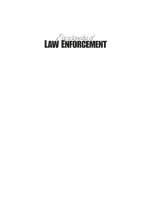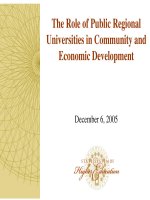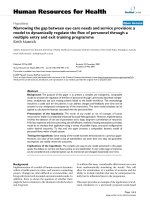Construction of whiteness through nomination, predication, argumentation and intensification or mitiga
Bạn đang xem bản rút gọn của tài liệu. Xem và tải ngay bản đầy đủ của tài liệu tại đây (323.88 KB, 8 trang )
TRIBHUVAN UNIVERSITY JOURNAL, VOL.: 32, NO.: 1, JUNE. 2018
197
CONSTRUCTION OF WHITENESS
THROUGH NOMINATION, PREDICATION,
ARGUMENTATION AND INTENSIFICATION OR
MITIGATION
Shuv Raj Rana Bhat*
ABSTRACT
In this paper, Mary Kingsley’s Travels in West Africa has
been analysed from the perspective of critical discourse analysis. In
particular, how Kingsley constructs whiteness through strategies
such as nomination, predication, argumentation and intensification
or mitigation has been explored. The natives from minor culture are
represented from the western terministic screens, to use K. Burke’s
phrase. The findings show that the strategies used are related to the
positive construction of self (West) and the negative presentation of
Other (Africa).
Key words: Nomination, predication, argumentation and intensification or
mitigation.
INTRODUCTION AND OBJECTIVE
At the very outset of this paper, a question may arise as to why
Kingsley’s Travels in West Africa should be studied from the perspective
of critical discourse analysis. Therefore, I would like to justify why critical
discourse analysis is an appropriate theoretical lens to probe into travel
writings such as Kinsley’s Travels in West Africa prior to introducing
critical discourse analysis. Commonly used as CDA, an abbreviated form,
it has proved to be almost indispensable for my research, as it provides
me with tools to examine the whole issue of language use by those in
power from a different perspective. In particular, I have looked into the
use of language from the perspective of the patient, to use semantic term
and critically analyzed the language used by people in power who are
responsible for maintaining hegemony in the society. A research without
a critical eye on the way language—racist expression—is used in Travels
in West Africa remains largely unexplored, incomplete and, therefore,
unjustifiable. Critical discourse analysis provides a means of understanding
how Kingsley’s text is ideologically relevant in the nineteenth century. I
side with Phadindra who believes in Wodak’s contention that “texts are
*
Mr. Bhat is PhD Scholar, University of Texas, EI Paso USA.
198 CONSTRUCTION OF WHITENESS THROUGH NOMINATION, ...
often sites of struggle in that they show traces of differing discourses and
ideologies all contending and struggling for dominance,” and language as
such, “provides a finely articulated vehicle for differences in power within
hierarchical social structures” (Upadhyaya), (2010).
Nineteenth century European travel writings more often than not
functions as a vehicle for colonial discourse, strategically representing nonEuropeans such as Asians and Africans in order to justify their subjugation,
and their land as a site of opportunity. First published in 1897, Mary
Kingsley’s Travels in West Africa is no exception. I commence this paper with
the contention that Travels in West Africa should be studied as a rhetorical
text, that Kingsley’s objective in depicting both the land and the people is
to represent Africa inherently disponible, a term used by Mary Louise Pratt
to indicate “available for improvement” through capitalism (Imperial Eyes
60). Working from this assertion, I use the concepts developed by Reisigl
& Ruth (2005) to explore the development of racialized constructions of
African identity and their ideological relationship to disponibility.
DISCUSSION
Beginning in disciplines such as semiotics and linguistics, the term
discourse plays an increasingly significant role in contemporary social
science. It has been eclectically used to refer to language use, larger units of
language such as paragraphs, conversations, interviews and specific systems
of meaning which form the identities of subjects and objects. Theorists such
as Jee (2011) go to such an extent as to distinguish “Discourse” with a
capital “D” from “discourse” with a little “d.” Jee (2011) uses “Discourse”
with big “D” to refer to:
Social languages [which] are varieties or styles of language used to
enact specific socially situated identities and activities (practices) associated
with those identities. But people enact identities not just through language,
but by using language together with other “stuff” that isn’t language. I
use the term “Discourse,” with a capital “D,” for ways of combining and
integrating language, actions, interactions, ways of thinking, believing,
valuing, and using various symbols, tools, and objects to enact a particular
sort of socially recognizable identity. (p. 201) Likewise, he reserves the
word “discourse” with a little “d,” “to mean language-in-use or stretches
of language (like conversations or stories)” (34). Jee’s (2011) capital
“Discourse” as a way of thinking, believing, and valuing comes closer
to Norman Fairclough’s idea of discourse analysis which basically aims:
to systematically explore often opaque relationships of causality and
TRIBHUVAN UNIVERSITY JOURNAL, VOL.: 32, NO.: 1, JUNE. 2018
199
determination between (a) discursive practices, events and texts, and (b)
wider social and cultural structures, relations and processes; to investigate
how such practices, events and texts arise out of and are ideologically
shaped by relations of power and struggles over power; and to explore how
the opacity of these relationships between discourse and society is itself a
factor securing power and hegemony (p. 135).
Norman Fairclough’s discussion of the aim of discourse analysis
as a way to explore opaque relationships between discursive practices
and wider social and cultural structures shows his affinity with the idea of
Wodak (2001). According to her, the primary objective of critical discourse
analysis is to analyze, “opaque as well as transparent structural relationships
of dominance, discrimination, power and control as manifested in language”
(204). She further explains that critical discourse analysis “studies real and
often extended instances of social interaction which take partially linguistic
form. The critical approach is distinctive in its view of (a) the relationship
between language and society, and (b) the relationship between analysis
and the practices analysed” (173). Highlighting the way language gains its
power, she repeats:
Language is not powerful on its own – it gains power by the use
powerful people make of it. This explains why CDA often chooses the
perspective of those who suffer, and critically analyzes the language use
of those in power, who are responsible for the existence of inequalities and
who also have the means and the opportunity to improve conditions. (p. 10).
This obviously highlights the discursivity involved in discourses of travel
writing and the subsequent impact on the people being represented. Given
the nature and scope of this study, it is limited to the analysis of the racial
issues in the nineteenth century England by picking five out of the many
different linguistic or rhetorical means by which persons are discriminated
against in a racist manner.To understand how racism is reproduced, we need
to understand how it is constructed linguistically. Drawing on the extensive
genealogy of discourse analytic approaches to textual analysis, most
recently those related to critical discourse analysis and social inequality,
practitioners of the critical discourse analysis have narrowed its focus with
respect to racist discourse to the given questions:
How are persons named and referred to linguistically? What traits,
characteristics, qualities and features are attributed to them? By means
of what arguments and argumentation schemes do specific persons or
social groups try to justify and legitimize the exclusion, discrimination,
200 CONSTRUCTION OF WHITENESS THROUGH NOMINATION, ...
suppression and exploitation of others? From what perspective or point
of view are these naming, attributions, and arguments expressed? Are
the respective discriminating utterances articulated overtly, are they even
intensified or are they mitigated? (Reisigl & Wodak 2005, p. 44). Based
on these, the discourse approach considers five types of strategies, all of
which are related to the positive construction of Self and the negative
presentation of Other. “Referential” or “nominational” strategies, are those
“by which one constructs and represents social actors: for example ingroups
and outgroups.”(45). Reisigl & Wodak (2005) indicate several ways this
can occur, including “reference by tropes, biological, naturalizing and
depersonalizing metaphors and metonymies, as well as by synecedoches
in the form of a part standing for the whole . . . or a whole standing in for
the part . . . (45). Because of the significance and prevalence of nomination
strategies, this approach draws as well from the Theo Van Leeuwen’s
system network of representation, incorporating such categories as
“passivization,” “impersonalization,” “collectivization,” “backgrounding,”
and “objectivation” (pp. 46-47).
European names, derogative names, denial of the name and sexism
are few of the many referential strategies by means of which writers like
Kingsley (1897) exhibit their racist attitude towards the indigenous people
of West Africa. The most fundamental form of rhetorical discrimination
is that of identifying persons linguistically by naming them derogatively
or vituperatively. Terminologies such as “nigger” and “savage” are more
than sufficient to perform racist idea as they connotatively convey insulting
meanings. Kingsley makes a profuse use of such terms in Travels in West
Africa. In the very opening chapter entitled “Liverpool to Sierra Leone and
the Gold Coast,” Kingsley (1897) describes her journey by rickshaw which
was being pulled by two Afro-Americans:
It was pulled in front by two government negroes and pushed
behind by another pair, all neatly attired in white jackets and knee breeches,
and crimson cummerbunds yards long, bound round their middles. Now
it is an ingrained characteristic of the uneducated negro, that he cannot
keep on a neat and complete garment of any kind. It does not matter what
that garment may be; so long as it is whole, off it comes. (p. 12). In this
quote, Kingsley (1897) uses the rhetoric of somatisation which is realized
through repeated somatonym or linguistic item “negroes” in order to show
their demeaning status. As a matter of fact, Kingsley’s text is replete with
racionyms such as “blacks,” “bush negroes,” bush-souls,” and “darkskin.” In chapter twelve, she refers to the natives as “the savage” to denote
TRIBHUVAN UNIVERSITY JOURNAL, VOL.: 32, NO.: 1, JUNE. 2018
201
primitivity or lack of civilization (140). But when it comes to addressing
people from her continent, she shows her great reverence. For example,
the name Nassau appears in the text in different forms as “Dr. Nassau” or
“The Rev. Dr. Nassau” (4). In the chapter sixteen titled “Ascent of the Great
Peak of Cameroons,” Kingsley refers to a group of local women in terms
of mental deficiency, “those foolish creatures” (202). Some of the names
Kingsley assigns to local people include “Smiles,” “Gray Shirt,” “Singlet,”
and “Pagan” which are based on physical appearances of superficial
behavioral patterns rather than personality. These names actually reduce
the African individuals nearly to objects. The only way for Kingsley to
understand them is through the process of christening. She must put them
in terms understandable to the Europeans, fitting them within a scheme
that is knowable and acceptable within ethnocentric British ideology. In so
doing, she denies their humanity. Sexist language can serve many different
purposes on the side of the writers—psychological, social or political.
“Linguistic exclusion,” contend Reisigl & Wodak (2005), “is not only
strategically employed to conceal persons responsible for discriminatory
activities, it has clearly discriminatory effects as in cases of sexist ignoring
of women by not naming them” (47). Kingsley’s (1897) use of reference
items such as “man” and “he” (55) exclude women from their own male
tribes. While Kingsley plays a feminine role while she is in England, she
shows her masculine behavior in Africa. The fact that she is addressed as
“sir” in Africa bears witness to this contention.
Closely related to reference, predicational strategies involve the use
of “stereotypical, evaluative attributions of negative and positive traits in the
linguistic form of implicit or explicit predicates” (45). It is noted that some
of the nominating terms can have the effect of being evaluative because “the
pure referential identification very often already involves a denotatively as
well as a connotatively . . . deprecatory or appreciative labeling of the social
actors” (45). Predication is a process of assigning qualities to persons,
animals, action and social phenomena. Predicational strategies are mainly
realized by specific forms of reference, attributes, predicates, collocations,
comparisons, similes, metaphors, synecdoches, metonymies, hyperboles
and allusions. In the chapter XVII entitled “Ascent to the Great Peak of
Cameroons,” Kingsley describes a scene in which she becomes an object
of gaze—the local people try to see her inside the room by pushing open
the window shutters. But when she refers to them, she uses expressions
such as “a mass of black heads” and “white teeth,” a predicational strategy
called synecdoche in which a part of something (black’s white teeth and
202 CONSTRUCTION OF WHITENESS THROUGH NOMINATION, ...
black heads) stands for the whole thing (black people). Likewise, Kingsley
presents Smiles, a name christened by Kingsley herself and his friends
as criminals: “frequent roll-calls were found necessary, so that crimes of
Smiles and his fellows might not accumulate to an unmanageable extent”
(240). The words “gang” and “liars” frequently occur in her narrative.
Argumentation strategies involve the way that the text functions
persuasively. This study considers argumentation strategies in a narrower
sense, primarily through the analysis of logical fallacies and topoi. Both of
these lie at the heart of racist discourse, for “[i]f one looks at the structure of
prejudices from an argumentation theoretical perspective, one can ascertain
that in every racist, antisemitic, nationalist, ethnicist and sexist prejudice
or stereotype there is inherent a fallacious generalisation” (Reisigl &
Wodak, 2005, p. 63). Frequently combined with fallacies, topoi are used to
justify negative attributes, social and political inclusion and exclusion, and
the “discrimination or preferential treatment of the respective persons or
groups of persons” (45). Reisigl and Wodak cite the work of Kienpointetner
in describing topoi as “parts of argumentation that belong to the obligatory,
either explicit or inferable, premises. They are the content-related warrants
or ‘conclusion rules’ that . . . justify the transition from the argument or
arguments to the conclusion” (qtd. in Discourse 74-75). A common topos
cited is that of “advantage” or “usefulness,” whereby if an action is considered
useful or beneficial, then it should be undertaken (75). The topoi used in
Travels in West Africatypically revolve around the need for change, such
as the alleged “backwardness,” of the people or the “ancient” condition of
the territory, both geologically and culturally. Other topoi are subordinated
to this main goal, focusing on more specific concerns such as the people’s
purportedly vice-ridden nature, lack of education, and unfitness for selfgovernance, to name just a few. In the following passage from “Trade and
Labour in West Arica,” Kingsley (1897) justifies why development of trade
is necessary:
The development of trade is a necessary condition for the existence
of the natives, and the discovery of products in the forests that will be
marketable in Europe, and the making of plantations whose products will
help to take the place of those he so recklessly now destroys, will give him
a safer future than can any amount of abolitions of domestic slavery, or
institutions of trial by jury, etc. If white control advances and plantations
are not made and trade with the interior is not expanded, the condition of
the West African will be a very wretched one, far worse than it was before
the export slave-trade was suppressed. (p. 256)
TRIBHUVAN UNIVERSITY JOURNAL, VOL.: 32, NO.: 1, JUNE. 2018
203
In the quote above, Kingsley creates a situation in which trade
becomes indispensable for the survival of the indigenous people. As
development of trade and plantation on the part of the natives are impossible,
white intervention is a must for their rescue. Likewise, below is given a quote
which is an extremely fallacious generalization: Keane says – ‘their inherent
mental inferiority, almost more marked than their physical characters,
depends on physiological causes by which the intellectual faculties seem
to be arrested before attaining their normal development’; and further on,
‘We must necessarily infer that the development of the negro and white
proceeds on different lines. While with the latter the volume of the brain
grows with the expansion of the brain-pan; in the former the growth of the
brain is on the contrary arrested by the premature closing of the cranial
sutures, and lateral pressure of the frontal bone.’ You will frequently meet
with the statement that the negro child is as intelligent, or more so, than
the white child, but that as soon as it passes beyond childhood it makes no
further mental advance.
Burton says: ‘His mental development is arrested, and thenceforth
he grows backwards instead of forwards.’ (p. 252). Keane represents the
black people as if they do not belong to the human species. To show that they
are different species, unlike the whites who are human species, he discusses
the way anatomy and physiology of the blacks function—contrary to the
mental development of the whites, the blacks grow backwards. This is an
extreme example of fallacious argument based not on logic but on racism.
Finally, “intensifying” or “mitigating” strategies are used to heighten or
blunt the force of racist statements. Linguistically, they “qualify and
modify the epistemic status of a proposition . . . . These strategies play an
important role in the discursive presentation inasmuch as they operate upon
it by sharpening it or toning it down” (Reisigl & Wodak (2005), p. 45).
Intensification and mitigation often occur through the degree of directness
or explicitness by which the speaker utters a racist statement.
When Kingsley quotes in dialect the African speakers she meets,
Africans are constructed as humorously primitive. For instance, one
member of her party, whom she calls a “distinguished sportsman” for his
ability to catch game, is quoted as describing his gaming practice thus:
“You go shoot thing with gun. Berra well—buy you no get him thing for
sure. No sah. Dem gun make nize. Berra well” (61). She further continues,
“You fren hear demnize and come look him, and you hab to go share what
you done kill. Or bad man hear him nize, and he come look him, and you
go fit to get share—you fit to get kill yusself. Chii! chii! traps be best!” (61).
204 CONSTRUCTION OF WHITENESS THROUGH NOMINATION, ...
While Kingsley gives lip service to praising the “distinguished sportsman”
she also belittles him, mockingly representing (phonetically) his attempt
at the English language. In other words, the expression “distinguished
sportsman” appears to be genuine approbation, yet the eye dialect used by
Kingsley presents such a vividly offensive image that the impact of the
positive reference is negated, or “mitigated.”
CONCLUSION
As the aforementioned analysis shows, critical discourse analysis
(CDA) explicates abuses of power promoted by Travels in West Africa, by
analyzing linguistic/semiotic details in light of the larger social and political
contexts. It particularly exhibits Mary Kingsley’s deployment of strategies
such as nomination, predication, argumentation and intensification or
mitigation in order to represent social actors especially African Bantu
People and Kingsley herself. The findings show that language is no longer a
neutral entity; it is rather ideologically charged. Kingsley’s choice of diction,
argument and conclusion show that she is an epitome of British imperialism
that seeks to eliminate the identity and existence of the non-western people
like Africans. Her abundance use of adjectives, politically incorrect words
and her method of arriving at conclusion are of particular interest because
they reek of racism and inequality. When it comes to addressing the white
audience in her home country, Kingsley is very much selective in the use of
words—honoured, powerful, intelligent and superior—that put them on a
pedestal, clearly investing positive attitude in the language she uses.
REFERENCES
Jee P. (2011). An introduction to discourse analysis: Theory and method.
(3rded.). New York: Routledge.
Kingsley, M. H. (1897). Travels in west Africa. London: Macmillan.
Reisigl, M. & Wodak, R. (2005). Discourse and discrimination: Rhetorics
of racism and anti-semitism. London: Routledge.
Upadhyaya, P. K. (2010). Politics of hegemony and denial in the rhetoric
of language and education policy in Nepal: A critical discourse
analysis of policy documents and government sponsored textbooks
(1960-2009). An unpublished dissertation, University of Texas,
Ann Arbor: UMI, 2010. 3433509.
Wodak, R. (2001). The discourse-historical approach. In methods of critical
discourse analysis. An unpublished dissertation, London: Sage,
2001. 63-94.









